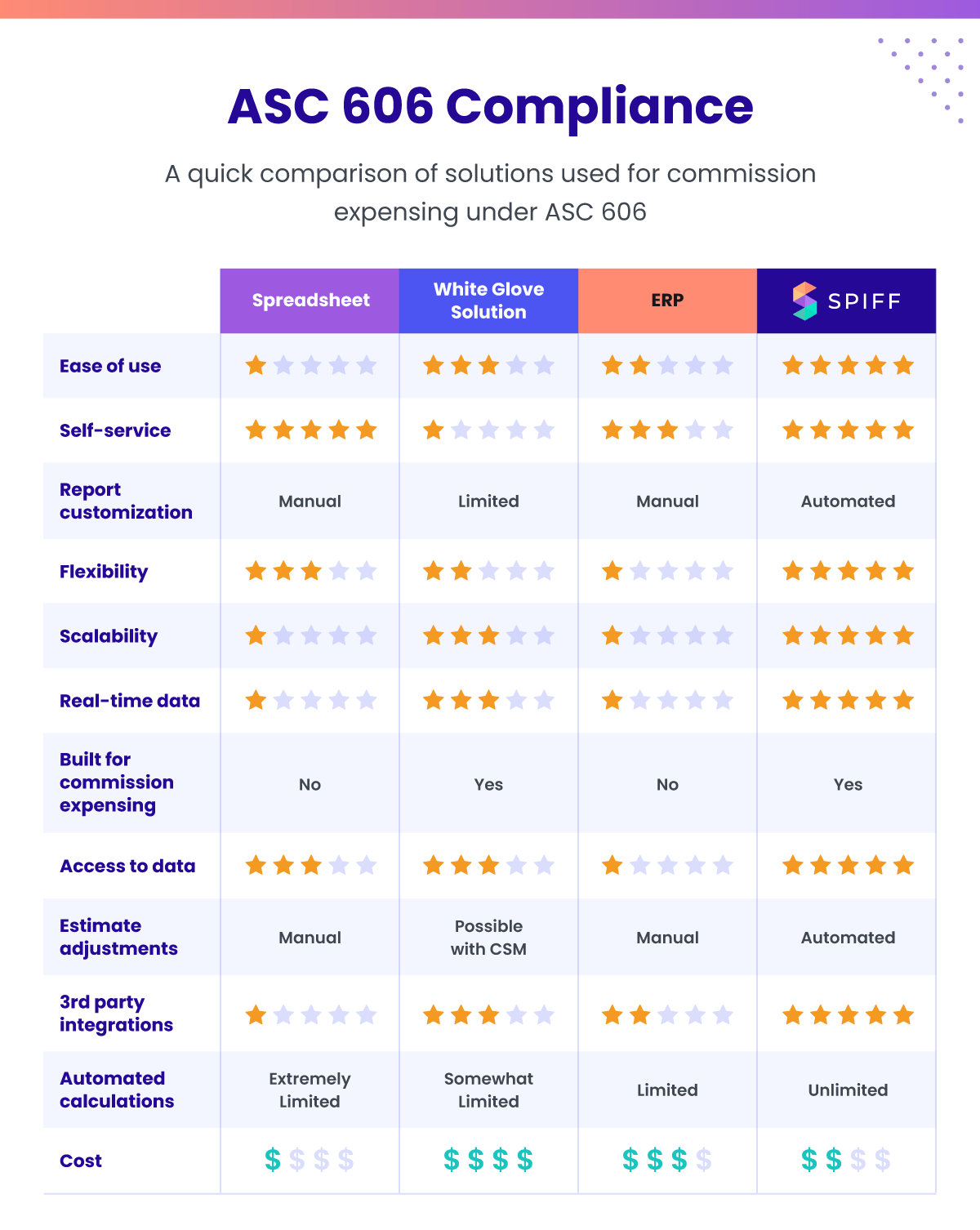ASC 606 compliance is kind of like taking a cross-country road trip without a GPS. It’s a long and arduous process, no matter where you’re coming from. You also have to follow some incredibly complex directions if you don’t want to get stranded by the side of the road (or fined by the SEC).
However, even though you’re referencing the same map as everyone else, your speed, efficiency, and ease of travel will vary greatly, depending on which vehicle you’ve chosen.
Think about it. ASC 606 changed the game when it comes to revenue reporting. Gone are the days when commission, bonuses, and incentive pay were accounted for as direct expenses. Now any costs incurred to obtain and fulfill contracts need to be amortized over the estimated customer lifetime. For SaaS companies, this is typically 3-5 years (source).
With all the complexities in ASC 606, your commission expensing process is more critical than ever. As the vehicle driving compliance at your organization, it will ultimately determine how quickly, accurately and painlessly you get there.
But which process is best? That depends on multiple factors, like the size of your organization, its growth trajectory, and other specific business requirements. In today’s blog post we take a look at the four most popular tools organizations use for commission expensing and the functional requirements you should look for when comparing your options. Here’s what you can expect:
The Four Types of Commission Expensing Solutions:
- DIY Commission Expensing
- White Glove Commission Expensing
- ERP Commission Expensing
- Self-Service Commission Expensing
Functional Requirements for ASC 606 Compliance
- Functionality that allows you to drill down into commission data
- The ability to adjust your forecasted estimates
- Robust integrations with other systems
- Accurate ASC 606 reporting
Let’s get started with a look at the four major types of commission expensing tools.
1. DIY Commission Expensing
This means doing everything yourself, from patching together data inputs to manually checking for errors. This method typically relies heavily on Excel spreadsheets to keep track of everything.
Using Excel or another type of commission spreadsheet has a couple benefits. For starters, it’s less expensive than many of the alternatives. It’s also more familiar— you can jump right in to your next ASC 606 report without having to stop and learn a new software. However, the DIY approach comes with some inherent challenges you’ll contend with sooner or later:
Barebones functionality:
There’s no doubt Excel is a versatile tool. But it also hasn’t changed much since it was first developed in the 1970’s. It certainly wasn’t built to handle the complexities of modern day commission expensing under ASC 606.
Even though Excel spreadsheets offer flexibility and can process unlimited formulas, you’re cut off from more robust functionality designed to make your job easier— like being able to quickly tap historical data to determine amortization periods, or automatically apply specific expensing rules for every opportunity.
When you think about it, the DIY approach is sort of like lumbering along the Oregon Trail in a covered wagon. You have the bare minimum required to survive an ASC 606 audit, but you’re also forced to rely on an archaic mode of transportation to reach compliance.
Manual tasks:
If a wheel went bust on the Oregon Trail, your journey would come to a screeching halt until you could repair it. The process was grueling— you had to unload your entire wagon, salvage hardware from the damaged wheel, chop wood to make a new one, install it, then pack everything up again. With a dizzying number of steps involved, it was easy for something to go wrong, and any mistake could be catastrophic.
Although fixing broken formulas or correcting mistakes in Excel might not be as physically demanding, it’s still a manual process. That means it A.) eats up a lot of your time, and B.) increases the likelihood for human error. It’s no surprise that over 80% of Excel spreadsheets have mistakes in them (source).
These odds become especially risky when you think about the vast number of controls you need to keep track of for revenue reporting. With the DIY approach, you can expect it to feel like you’re scrambling to get as far as you can before something inevitably breaks, just like you would in a covered wagon.
Limited scalability:
Excel spreadsheets aren’t just manual in nature. They’re also not easily shareable. This gives you limited ability to collaborate. This can lead to bottlenecks as your organization expands and you have increasingly complex commissions to expense.
2. White glove commission expensing
White glove commission expensing operates on “bespoke” software that’s been heavily customized for your organization. Vehicle wise, it’s sort of like being chaperoned across the country in a limousine.
From a distance, this upgrade seems like a no-brainer, especially compared to a covered wagon. However, there are some significant challenges with white glove commission expensing you should be aware of, so you can decide if it’s worth the trade-off:
Third-party dependency:
Normally, when we hear “bespoke” or “white glove”, we think premium—like a suit or dress hand tailored to your exact measurements. Similarly, bespoke commission software is engineered to adapt its core functionality to your organization’s specific needs.
But what happens when those needs change?
As your organization rolls out more products or expands to new markets and territories, commission gets more complicated— and so does your expensing.
Now, a lot of software is “customizable”, but it’s important to understand what exactly a company means when they describe themselves as such.
Are you able to make modifications and implement new business rules yourself? With a white glove approach, the answer is… probably not. Due to its complexity, even smaller changes typically require engineering proficiency and deep expertise with the legacy code that particular software was built on.
Bespoke software is technically customizable— for your vendor’s engineers. But when you can’t make any changes yourself, you’re forced to rely on a third-party to adapt your software to keep up with shifting requirements.
Limited scalability:
When you don’t have the ability to modify how you use your commission expensing software, you’re essentially surrendering the driver’s seat.
Sure, a white glove approach may be a more “premium” option than a creaky covered wagon. But you can’t control the speed of the journey, or where and when to pull over. Everything ultimately depends on your vendor and their ability to keep pace with new business rules. Scalability is seriously limited.
Something else to consider is the speed at which regulation and compliance changes. With a white glove approach, by the time your latest batch of adjustments have been implemented, they may no longer be relevant.
Besides, if your vendor experiences employee turnover, you may be assigned a new CSM every couple of months. With each new CSM, you are forced to wait while they get acquainted with your business model. You’re essentially putting commission expensing in someone else’s hands– someone who doesn’t have to suffer the consequences should you fail to comply with ASC 606 regulations.
High cost of ownership:
When it comes to ASC 606 compliance, a white glove approach is by far the most expensive way to travel. “Bespoke” software that’s been manually customized for your organization is a hefty investment right off the bat, but there are additional costs you’ll need to consider as well.
Because white glove commission expensing relies on a third-party for modifications, you’ll need to budget for professional service fees down the road. Like hiring a limo driver, the longer you go, the more expensive it gets— especially because vendors are positioned to take advantage of the high barriers to exit and may hike their prices accordingly.
This will ultimately drive up your total cost, and should be factored into the equation from the start.
3. ERP Commission Expensing
Enterprise Resource Planning (ERP) software pulls different processes together into one central system. If your organization is already managing its finances, operations/supply chain, reporting, and HR through ERP, why not use it for your commission expensing as well?
In a way, it makes sense. With everything in one place, you won’t have to worry about wrangling disparate data sources. But, like every other vehicle that can get you to ASC 606 compliance, there are also some hurdles:
Not purpose-built for commission expensing:
Using an ERP for commission expensing is kind of like taking a cross-country road trip in a tractor. It’s technically a mode of transportation, and certainly comes in handy for certain tasks. But it also wasn’t designed for long distance travel.
Similarly, ERPs weren’t specifically built for commission expensing. They definitely offer some helpful features, like automated calculations, high-level data, and even revenue tracing. One thing ERPs can’t do, however, is process the vast amounts of granular commission data you’ll need for your ASC 606 audit.
Overly complicated
If you’re using an ERP for commission expensing, you’re bound to run into some similar problems as you would with Excel. Both were built to accommodate a dizzying number of use cases, which often results in a bulky, complicated system you’re forced to navigate.
Effectively managing an ERP usually involves a steep learning curve and extensive onboarding before you can get up and running. It also takes longer to run your commission expensing process than a simplified alternative focused on the functionality you actually need, without the additional bloat.
Expensive:
ERPs require a big investment— not just in the initial costs of implementing a massive, complex system, but also in the excessive hours required to make sense of it. This means that the barrier to exit is high. Similar to white glove commission expensing, vendors are incentivized to continually increase their prices.
4. Self-Service Commission Expensing
Self-service commission expensing typically operates on a low-code/no-code system— that is, software specifically designed to allow customers to make their own modifications. However, there are a few things you’ll need to consider when choosing this option:
Learning a new system:
Any Excel alternative means ditching familiarity and old habits. Self-service software is no exception, and requires onboarding. This may cause temporary delays before you can get up and running on your next ASC 606 report— although the amount of time will vary by vendor.
Front loading:
Although self-service software was built for quick and easy modifications, it’s still not grab and go. In order for your commission expensing process to operate like a well-oiled machine, you’ll typically need to configure your commissionable components or portfolios first.
This isn’t necessarily a bad thing— front loading the bulk of your efforts instead of implementing them in smaller steps over an extended period of time means rarely having to stop or pull over once you’ve hit the road.
Price point:
Self-service commission expensing software can come with a higher price tag— at least first. However, it’s a very different business model from similarly expensive white glove alternatives.
As we briefly touched on, bespoke vendors may initially offer complex, custom builds for less money, trusting that you’ll eventually require their engineering support to make any changes. This secures steep professional service fees in the future to make up for initially competitive pricing.
Functional Requirements for ASC 606 Compliance
Despite major differences between DIY, white glove, ERP, and self-serve commission expensing, the underlying functional requirements for ASC 606 audits remain the same.
How those functions are actually executed, however, depend on your vehicle. No matter which process you choose, it will need to include the following:
Functionality that allows you to drill into commission data
To comply with ASC 606, you’ll need historical data for expensing commissions over time, instead of when incurred. This data also helps you understand how variable compensation is paid at your organization— so you can more effectively determine amortization periods.
Beyond the historical data, you’ll need to track every commissionable component, determine which commissions are incremental costs (if any), and allocate costs to multiple performance obligations within every contract.
So basically, you need data. A lot of data. But where does this data come from?
The answer to this question will likely change depending on which solution you choose to help manage your commission expensing process. Let’s take a look at each:
- DIY: This usually entails duct taping data together from disparate sources. Whether you’re exporting data from your CRM or dropping inputs from SalesOps or RevOps into your spreadsheets, the process is almost entirely manual. Excel’s sparse automation capabilities also mean that none of the data you’re gathering is updated in real-time. You’ll most likely need to repeat multiple imports, and regularly check to ensure accuracy.
- White glove: Bespoke software usually comes with the ability to process commission data, and might even include customized dashboards. However, if expense rules are hard-coded on the backend, remember, you’ll need to go through a CSM anytime you make a change to how you pay commissions.
- ERP: Getting ahold of detailed commission data is especially challenging with an ERP. ERPs are better suited for high-level transaction summaries, rather than diving into portfolios and performance obligations. To fill in the gaps, you may need to go through the same manual process as you would with Excel.
- Self-service: Self-service software is intentionally built to automate as much as possible— that’s part of the reason it’s so easy to operate on your own. When it comes to commission expensing, this can afford you some helpful capabilities, like automatically pulling in real-time data and applying pre-determined commission rules for capitalization or amortization.
The ability to adjust your forecasted estimates
Under ASC 606, intangible assets like commissions need to be reported as forecasted estimates. This can get tricky when you factor in customer churn, changing contracts, and employee turnover, all of which can significantly impact commission expensing.
Odds are, you’ll need to adjust your estimates at some point along the journey. But what does that process look like?
Again, the answer to this question depends on which vehicle you’ve chosen to drive the commission expensing process. Let’s explore the options:
- DIY: Without a systematic process, any estimate adjustments will likely involve manually updating/exporting the necessary data and then re-configuring your spreadsheets. Excel also doesn’t have sophisticated version control functionality, which makes it tough to spot when and where adjustments were made.
- White glove: Your ability to update estimates using bespoke software will vary by the complexity of your build. For example, you may be able to independently automate true ups for contract events, but then have to route a request through your CSM to adjust fixed amortization schedules.
- ERP: Since ERPs typically don’t automate any commission modifications, you’ll need to adjust estimates through a separate manual process, then reconfigure the original data.
- Self-service: With automation baked into self-service software, updating estimates is simple and straightforward. Depending on your platform, you may also be able to run specific expense rules for each estimate, or manage exceptions and fringe benefits without having to touch a line of code (or beseech your CSM for help).
Robust integrations with other systems
ASC 606 requires granular details about every commissionable event. At most organizations, the data you need is probably dispersed across multiple sources, like your CRM, ERP, HCM or payroll and invoicing systems.
So how do you pull it all together? You know the drill!
- DIY: Collecting data for commission expensing is especially cumbersome with a DIY approach. Since Excel has no ability to integrate with other systems, you have to manually export/import from each source individually, then configure the data in your spreadsheets. Depending on your organization, you might not have access to every data source you need. In that case, you’ll have to loop in other teams, like sales operations, finance, or HR.
- White glove: Your bespoke software may easily sync with other systems, especially if this was a requirement from the start. However, if existing connectors aren’t compatible with your CRM, or you switch to new tools or systems in the future, this may require going through a CSM to facilitate custom integrations.
- ERP: ERPs typically use “general ledgers” to record transactions across a set of master accounts. This will be a helpful starting point, but unless your ERP is also equipped with sub-ledgers specifically built for commissions, you’ll probably need to follow a similar process as the one we discussed with DIY commission expensing.
- Self-service: Low-code/no-code software built with self-service in mind may offer Open Data API, which lets you easily pull data from other systems. Depending on which tools you’re using, you may also be able to export your data. This comes in handy down the road, if or when your financial statements are subject to SOX audits.
Accurate ASC 606 report building
With an abundance of nuanced, minute details to keep track of, translating your datasets into a usable format is crucial to any ASC 606 process. Otherwise, you’ll be left with a massive data dump that no one can make sense of.
Let’s take a look at each of the options we presented today and see how they stack up:
- DIY: This usually involves manually pulling together your final numbers across all of your spreadsheets, then building your ASC 606 report from scratch.
- White glove: With bespoke software, vendors typically offer some “out-of-the-box” report options that any customer can use. If this is enough to fit your needs, your reporting should be pretty straightforward. However, any adjustments will likely require assistance from a CSM.
- ERP: Since ERPs weren’t built for complex commission expense accounting, it’s understandable that they also don’t give you detailed reporting abilities. Similar to the DIY approach, you’ll probably need to manually build any ASC 606 reports.
- Self-service: A good low-code/no-code software should enable you to customize and export your ASC 606 reports. Since self-service options often run on a more modern code base than their bespoke/legacy counterparts, you can also typically take advantage of a clean interface and data visualization to enhance your reports further.
Choosing the right tool for ASC 606 Compliance
We’ve covered a lot in this article. And, let’s be honest, we know you’re busy. If you’re looking for a quick TLDR, we’ve got you covered. We put together this handy graphic to help you decide which solution is best for your needs. Check it out:

Expensing Commissions Under ASC 606 with Spiff
As of the publish date on this article, Spiff is the only platform that falls under the category of self-service commission expensing. While other platforms in our space claim to automate commissions- that doesn’t cover ASC 606 compliance.
Instead, our biggest competitors typically fall under the category of white glove solutions. This means their customers can’t build their own ASC 606 reports or access the data they need within the platform’s UI.
Spiff on the other hand, is true commission automation- including ASC 606 compliance. Forget hours of manual work, forget waiting around for your professional services team, and forget thousands of extra dollars in billed time. With Spiff, you can build the reports you need, access historical data, and maintain compliance with ASC 606 in minutes with just a few clicks.
About Spiff
Spiff is a new class of software that creates trust across the organization by delivering real-time automation of commission calculations and motivates teams to drive top-line growth. With a combination of an intuitive UI, real-time visibility, and seamless integrations into current systems, Spiff is the first choice among high-growth businesses. Spiff’s sales commission software enables finance and sales operations teams to self-manage complex incentive compensation plans and provides transparency for sales teams.






